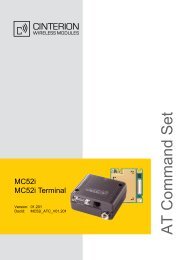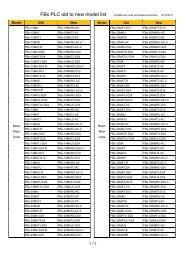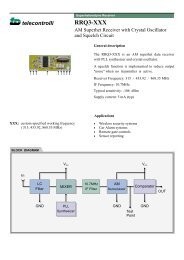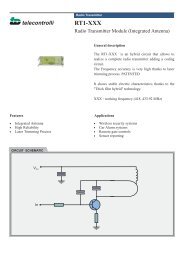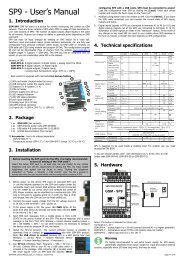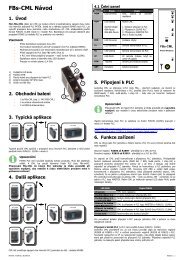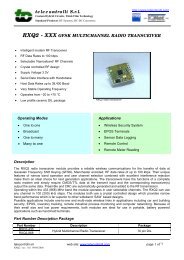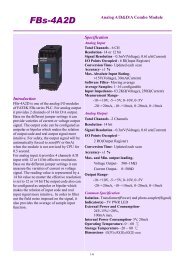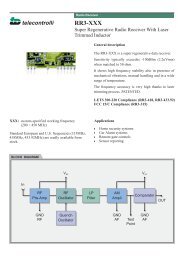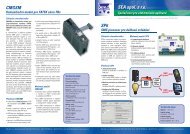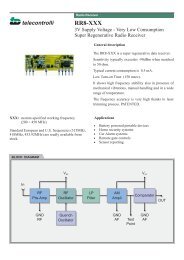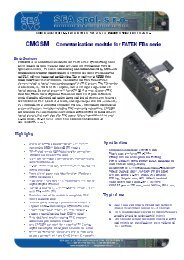Chapter 21 Temperature Measurement of FBs-PLC and PID Control
Chapter 21 Temperature Measurement of FBs-PLC and PID Control
Chapter 21 Temperature Measurement of FBs-PLC and PID Control
Create successful ePaper yourself
Turn your PDF publications into a flip-book with our unique Google optimized e-Paper software.
FUN86<br />
TPCTL<br />
Convenient Instruction <strong>of</strong> <strong>PID</strong> <strong>Temperature</strong> <strong>Control</strong><br />
FUN86<br />
TPCTL<br />
Principle <strong>of</strong> <strong>PID</strong> parameter adjustment<br />
● As the gain (Kc) adjustment getting larger, the larger the proportional contribution to the output. This can<br />
obtain a sensitive <strong>and</strong> rapid control reaction. However, when the gain is too large, it may cause oscillation.<br />
Do the best to adjust “Kc” larger (but not to the extent <strong>of</strong> making oscillation), which could increase the<br />
process reaction <strong>and</strong> reduce the steady state error.<br />
● Integral item may be used to eliminate the steady state error. The larger the number ( Ki, integral tuning<br />
constant, Ki=1/Ti ), the larger the integral contribution to the output. When there is steady state error, adjust<br />
the “Ki” larger to decrease the error.<br />
When the “Ki” = 0, the integral item makes no contribution to the output.<br />
For example : if the reset time is 5 minutes, Ki=1/Ti=100/5=20;It means integral tuning constant is 0.2 Repeat/Minute<br />
● Derivative item may be used to make the process smoother <strong>and</strong> not too over shoot. The larger the number<br />
(Td, derivative tuning constant), the larger the derivative contribution to the output. When there is too over<br />
shoot, adjust the “Td” larger to decrease the amount <strong>of</strong> over shoot.<br />
When the “Td” = 0, the derivative item makes no contribution to the output.<br />
For example : if the rate time is 1 minute, then the Td = 100; if the differential time is 2 minute, then the Td = 200.<br />
● Properly adjust the <strong>PID</strong> parameters can obtain an excellent result for temperature control.<br />
● The default solution interval for <strong>PID</strong> calculation is 4 seconds (Ts=40).<br />
● The default <strong>of</strong> gain value (Kc) is 110, where Pb=1000/110×0.1%≒0.91%; the system full range is 1638°, it<br />
means the value SP-14.8° (1638×0.91≒14.8) will let <strong>PID</strong> operation enter proportional b<strong>and</strong> control.<br />
● The default <strong>of</strong> integral tuning constant is 17<br />
● The default <strong>of</strong> derivative tuning constant is50, it means the rate time is 0.5 minutes (Td=50).<br />
● When changing the <strong>PID</strong> solution interval, it may tune the parameters Kc, Ki, Td again.<br />
Instruction guide<br />
● FUN86 will be enabled after reading all temperature channels.<br />
● When execution control “EN” = 1, it depends on the input status <strong>of</strong> H/C for <strong>PID</strong> operation to make heating<br />
(H/C=1) or cooling (H/C=0) control. The current values <strong>of</strong> measured temperature are through the<br />
multiplexing temperature module ; the set points <strong>of</strong> desired temperature are stored in the registers starting<br />
from Sv. With the calculation <strong>of</strong> s<strong>of</strong>tware <strong>PID</strong> expression, it will respond the error with an output signal<br />
according to the setting <strong>of</strong> set point, the error's integral <strong>and</strong> the rate <strong>of</strong> change <strong>of</strong> the process variable.<br />
Convert the output <strong>of</strong> <strong>PID</strong> calculation to be the time proportional on/<strong>of</strong>f (PWM) output, <strong>and</strong> via transistor<br />
output to control the SSR for heating or cooling process; where there is a good performance <strong>and</strong> very low<br />
cost solution. It may also apply the output <strong>of</strong> <strong>PID</strong> calculation (stored in registers starting from OR), by way<br />
<strong>of</strong> D/A analog output module, to control SCR or proportional valve, so as to get more precise process control.<br />
● When the setting <strong>of</strong> Sn, Zn (0 Sn 31 <strong>and</strong> 1 Zn 32, as well as 1 Sn + Zn 32) comes error, this<br />
instruction will not be executed <strong>and</strong> the instruction output “ERR” will be ON.<br />
● This instruction compares the current value with the set point to check whether the current temperature falls<br />
within deviation range (stored in register starting from Os). If it falls in the deviation range, it will set the<br />
in-zone bit <strong>of</strong> that point to be ON; if not, clear the in-zone bit <strong>of</strong> that point to be OFF, <strong>and</strong> make instruction<br />
output “ALM” to be ON.<br />
<strong>21</strong>-13



